List of Russian dishes
This is a list of notable dishes found in Russian cuisine.[1] Russian cuisine is a collection of the different cooking traditions of the Russian peoples. The cuisine is diverse, with Northeast European/Baltic, Caucasian, Central Asian, Siberian, East Asian and Middle Eastern influences.[2] Russian cuisine derives its varied character from the vast and multi-ethnic expanse of Russia.
Russian dishes
Zakuski
| Name | Image | Description |
|---|---|---|
| Caviar |  |
Processed, salted roe, often of sturgeon[3] |
| Courgette caviar | 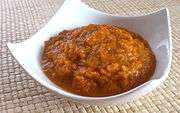 |
Cold entrée made of stewed vegetables (predominantly courgettes). Usually it is eaten with bread[4] |
| Kasha | 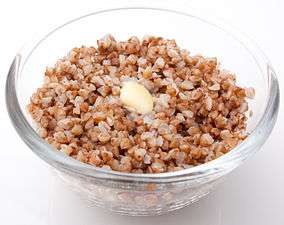 |
Porridge. Buckwheat,[5] millet, oat, wheat and semolina kashas are widely popular in Russia.[6][7] |
| Kholodets | A meat jelly that is also known as studen[7][8] | |
| Knish |  |
A baked or fried potato dumpling made of flaky dough[9][10] |
| Salo | 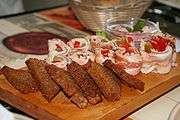 |
Is a food consisting of cured slabs of fatback (rarely pork belly), with or without skin. |
| Stroganina | 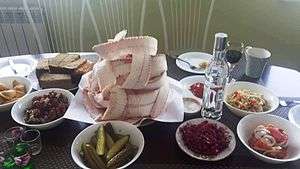 |
A dish of the indigenous people of northern Arctic Siberia consisting of raw, thin, long-sliced frozen fish. |
| Zakuski |  |
Refers to a variety of hors d'oeuvres, snacks, appetizers, usually served buffet style.[11] It often includes cold cuts, cured fishes, mixed salads, kholodets, various pickled vegetables and mushrooms, pirozhki, caviar, deviled eggs, open sandwiches, canapés and breads.[11] |
| Julienne | 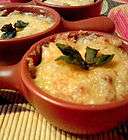 |
Мushrooms in cream or béchamel sauce topped with grated cheese and baked in a cocotte. Chicken, fish or seafood can also be used with or instead of mushrooms. |
Soups
| Name | Image | Description |
|---|---|---|
| Borscht | 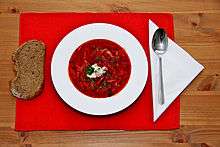 |
It is traditionally made from meat or bone stock, sautéed vegetables, and beet sour (i.e., fermented beetroot juice). Depending on the recipe, some of these components may be omitted or substituted for. |
| Okroshka | 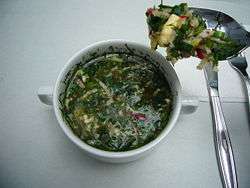 |
Cold soup of mostly raw vegetables like cucumbers, spring onions, boiled potatoes, with eggs, and a cooked meat such as beef, veal, sausages, or ham with kvass, topped with sour cream[12] |
| Rassolnik | 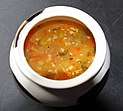 |
A soup made from pickled cucumbers, pearl barley, and pork or beef kidneys[13] |
| Shchi |  |
A cabbage soup.[14] Also can be based on sauerkraut.[14] Kislye Shchi (sour shchi) despite its name is a fizzy beverage similar to kvass, usually with honey. |
| Svekolnik | .jpg) |
A type of cold borscht |
| Solyanka |  |
A thick, spicy and sour soup that contains meat and pickled cucumbers[15] |
| Sorrel soup (green shchi) |
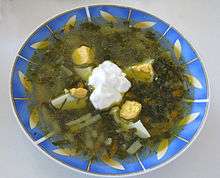 |
Water or broth, sorrel leaves, salt, sometimes with whole eggs or egg yolks, potatoes, carrots, parsley root, and rice[16][17] |
| Ukha | 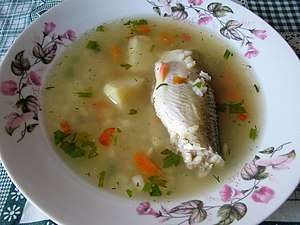 |
A clear soup, made from various types of fish[18] |
Salads
| Name | Image | Description |
|---|---|---|
| Dressed herring (Seld pod shuboi) | 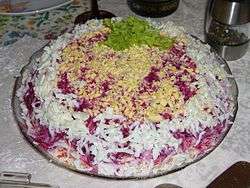 |
Diced, salted herring covered with layers of grated, boiled vegetables (potatoes, carrots, beet roots), chopped onions, and mayonnaise[19][7] |
| Mimosa salad | 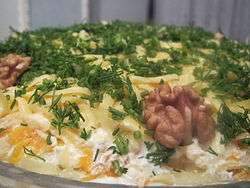 |
A festive salad, whose main ingredients are cheese, eggs, canned fish, onion, and mayonnaise |
| Olivier salad (Stolichniy salad) | Diced potatoes, eggs, chicken or bologna, sweet peas, and pickles with a mayonnaise dressing. Other vegetables, such as carrot or fresh cucumbers, can be added.[20][7] | |
| Vinegret |  |
Diced boiled vegetables (beet roots, potatoes, carrots), chopped onions, and sauerkraut and/or pickled cucumbers.[21][22][23] Other ingredients, such as green peas or beans, are sometimes also added.[22][23] Dressed with vinaigrette, mayonnaise or simply with sunflower or other vegetable oil. |
Meat dishes
| Name | Image | Description |
|---|---|---|
| Beef Stroganoff | 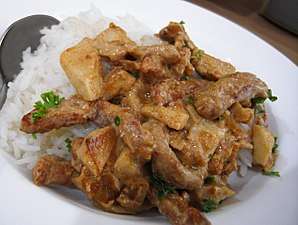 |
Pieces of sautéed beef in sauce, with smetana (sour cream)[24] |
| Chicken Kiev |  |
A dish made of chicken fillet pounded and rolled around cold butter, then coated with eggs and bread crumbs, and either fried or baked. |
| Golubtsy |  |
Cooked cabbage leaves wrapped around a variety of fillings[25][7] |
| Makarony po-flotski |  |
Literally navy-style pasta, a dish made of cooked pasta (typically macaroni, penne or fusilli) mixed with stewed ground meat, fried onions and seasoned with salt and black pepper. |
| Pelmeni |  |
Dumplings consisting of a meat filling wrapped in thin, pasta dough[26][27][7] |
| Pozharsky cutlet |  |
A breaded ground chicken patty[28] |
| Shashlyk | 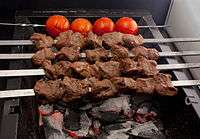 |
A dish of skewered and grilled cubes of meat. |
| Veal Orlov | 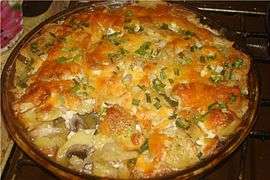 |
A dish invented by the French[29] consisting of braised loin of veal, thinly sliced, filled with a thin layer of pureed mushrooms and onions between each slice, topped with bechamel sauce and cheese. Various versions of this dish usually go by the name French-style meat in Russia today. |
Pancakes
| Name | Image | Description |
|---|---|---|
| Blini | 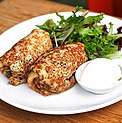 |
Pancakes of various thickness and ingredients[30][7] |
| Oladyi |  |
Small thick pancakes[31] |
| Syrniki (tvorozhniki) |
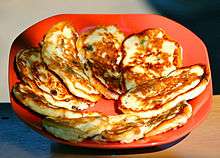 |
Fried pancakes made of quark, usually topped with sour cream, varenye, jam, honey, or apple sauce[32][33] |
Bread
| Name | Image | Description |
|---|---|---|
| Baranka | 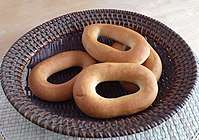 |
A dough ring somewhat smaller than a bublik, but also thinner and drier |
| Borodinsky bread |  |
Dark brown sourdough rye bread |
| Bublik | A ring of yeast-leavened wheat dough, that has been boiled in water for a short time before baking | |
| Karavai | 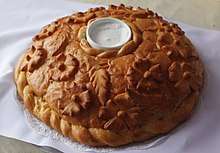 |
A large round braided bread, traditionally baked from wheat flour and decorated with symbolic flags and figurines, such as suns, moons, birds, animals, and pine cones. |
| Kalach | Historically, kalach meant any kind of white bread, and before modern methods of grinding wheat came into use, white bread was classed as a type of fancy bread. | |
| Kulich | One of the two sine qua non attributes of the Russian Easter (the other is Paskha).[34] A type of Easter bread.[34] | |
| Sushki | 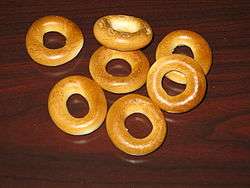 |
Traditional small, crunchy, mildly sweet bread rings eaten for dessert, usually with tea or coffee |
Pirogi (pies)
| Name | Image | Description |
|---|---|---|
| Kulyebyaka |  |
A fish (usually salmon or sturgeon) loaf, with rice, hard-boiled eggs, mushrooms, and dill[35] |
| Karelsky pirog | 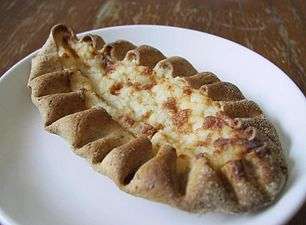 |
A traditional pirog from the region of Karelia. |
| Kurnik | 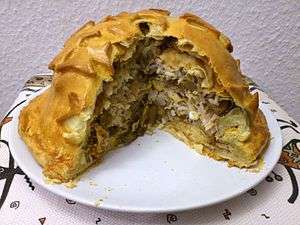 |
A dome-shaped savoury type of Russian pirog, usually filled with chicken or turkey, eggs, onions, kasha or rice, and other optional components.[36][37] |
| Rasstegai |  |
The filling usually contains fish, but may also contain meat, liver, rice or mushrooms. |
| Pirog |  |
A pie either with a sweet or savoury filling[38] |
| Pirozhki | Small pies[39][7] | |
| Vatrushka |  |
A pastry with a ring of dough and sweet farmer's cheese in the middle[40] |
Sauces
| Name | Image | Description |
|---|---|---|
| Khren | A spicy paste made of grated horseradish. | |
| Khrenovina | 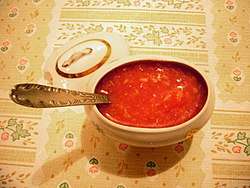 |
A spicy horseradish sauce served with a main course, which is very popular in Siberia. |
| Smetana | It is a dairy product produced by souring heavy cream. |
Desserts
| Name | Image | Description |
|---|---|---|
| Guriev porridge | 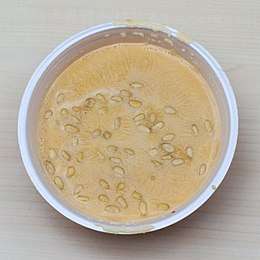 |
A Russian porridge dish prepared from semolina and milk with the addition of nuts (hazelnut, walnuts, almonds), kaimak (creamy foams) and dried fruits.[41] |
| Kutia | 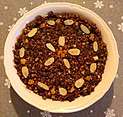 |
A ceremonial grain dish with sweet gravy. |
| Paskha |  |
Tvorog (farmer's cheese) plus heavy cream, butter, sugar, vanilla, etc., usually molded in the form of a truncated pyramid. Traditional for Easter. |
| Pryanik | A range of traditional sweet baked goods made from flour and honey. | |
| Pastila | 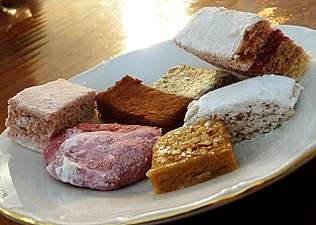 |
It has been described as "small squares of pressed fruit paste"[1] and "light, airy puffs with a delicate apple flavor". |
| Varenye | It is made by cooking berries, other fruits, or more rarely nuts, vegetables, or flowers, in sugar syrup. | |
| Zefir | A type of soft confectionery made by whipping fruit and berry purée (mostly apple puree) with sugar and egg whites with subsequent addition of a gelling agent like pectin, carrageenan, agar, or gelatine. |
Beverages
Non-alcoholic drinks
| Name | Image | Description |
|---|---|---|
| Kissel |  |
Fruit dessert of sweetened juice, thickened with arrowroot, cornstarch or potato starch[42] |
| Kompot |  |
Non-alcoholic sweet beverage, that may be served hot or cold, depending on tradition and season. It is obtained by cooking fruit such as strawberries, apricots, peaches, apples, rhubarb, gooseberries, or sour cherries in a large volume of water, often together with sugar or raisins as additional sweeteners. |
| Kvass |  |
A fermented non-alcoholic beverage made from black or regular rye bread or dough[43] |
| Mors | A non-carbonated Russian fruit drink[44][45][46] prepared from berries, mainly from lingonberry and cranberry (although sometimes blueberries, strawberries, sea buckthorns or raspberries). | |
| Ryazhenka | It is made from baked milk by lactic acid fermentation.[47] | |
| Varenets | 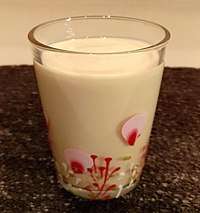 |
A fermented milk product that is popular in Russia.[48][49] Similar to ryazhenka, it is made by adding sour cream (smetana) to baked milk.[49] |
Alcoholic drinks
| Name | Image | Description |
|---|---|---|
| Medovukha | 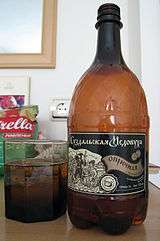 |
A traditional Russian honey-based drink analogous to its counterparts of other Indo-European peoples[50] |
| Sbiten | A traditional Russian honey-based drink similar to Medovukha[51] | |
| Vodka |  |
It is composed primarily of water and ethanol, but sometimes with traces of impurities and flavorings. Traditionally it is made by distilling the liquid from cereal grains or potatoes that have been fermented, though some modern brands use fruits or sugar as the base. |
gollark: Yes.
gollark: ρεεεεεεεεεεεε
gollark: I know our local MP. He is very politician.
gollark: The north south west east.
gollark: I'm actually in the north east, which is doing rather terribly too.
See also
References
- Classic Russian Cooking, Elena Molokhovets ("A Gift to Young Housewives"), Indiana University Press, 1992, ISBN 0-253-36026-9
- "The World Factbook". Cia.gov. Retrieved 27 December 2014.
- Mitchell, C. (2009). Passport Russia 3rd Ed., eBook. World Trade Press. p. 83. ISBN 978-1-60780-027-9. Retrieved December 23, 2017.
- "Courgette caviar, recipe". FalkTime. Retrieved 2019-07-10.
- Molokhovets, E.; Toomre, J. (1998). Classic Russian Cooking: Elena Molokhovets' a Gift to Young Housewives. Indiana-Michigan Series in Rus. Indiana University Press. p. 334. ISBN 978-0-253-21210-8. Retrieved December 23, 2017.
- Goldstein, D. (1999). A Taste of Russia: A Cookbook of Russian Hospitality. Russian Life Books. p. 126. ISBN 978-1-880100-42-4. Retrieved December 23, 2017.
- "Don't Miss These 10 Russian Dishes When Going To The World Cup". caspiannews.com. November 29, 2017. Retrieved 23 December 2017.
- Encyclopaedia of Contemporary Russian. Taylor & Francis. 2013. p. 296. ISBN 978-1-136-78786-7. Retrieved December 23, 2017.
- "Recipe: Knish – The Carbohydrate-Laden Jewish Comfort Food". The Moscow Times. Retrieved December 23, 2017.
- Mack, G.R.; Surina, A. (2005). Food Culture in Russia and Central Asia. Food culture around the world. Greenwood Press. p. 138. ISBN 978-0-313-32773-5. Retrieved December 23, 2017.
- Schultze, S. (2000). Culture and Customs of Russia. Culture and Customs of Europe. Greenwood Press. p. 65. ISBN 978-0-313-31101-7. Retrieved December 23, 2017.
- Goldstein, D. (1999). A Taste of Russia: A Cookbook of Russian Hospitality. Russian Life Books. p. 125. ISBN 978-1-880100-42-4. Retrieved December 23, 2017.
- Schultze, S. (2000). Culture and Customs of Russia. Culture and Customs of Europe. Greenwood Press. p. 66. ISBN 978-0-313-31101-7. Retrieved December 23, 2017.
- Wright, C.A. (2011). The Best Soups in the World. Houghton Mifflin Harcourt. p. pt51. ISBN 978-0-544-17779-6. Retrieved December 23, 2017.
- Sheraton, M.; Alexander, K. (2015). 1,000 Foods to Eat Before You Die: A Food Lover's Life List. 1,000-- before you die book. Workman Publishing. pp. 420–421. ISBN 978-0-7611-4168-6. Retrieved December 23, 2017.
- Gorina, R. (1945). Russian Fare: A Selection of Recipes. New Europe Publishing Company Limited. p. 6. Retrieved December 23, 2017.
- Meyers, P. (1978). The peasant kitchen: a return to simple, good food. Vintage Books. pp. 97–98. ISBN 978-0-394-72651-9. Retrieved December 23, 2017.
- Goldstein, D. (1999). A Taste of Russia: A Cookbook of Russian Hospitality. Russian Life Books. p. 51. ISBN 978-1-880100-42-4. Retrieved December 23, 2017.
- Calzolaio, Scott (December 19, 2017). "What's cooking this holiday season". Milford Daily News. Retrieved December 23, 2017.
- Perianova, I. (2013). The Polyphony of Food: Food through the Prism of Maslow’s Pyramid. Cambridge Scholars Publishing. p. 137. ISBN 978-1-4438-4511-3. Retrieved December 23, 2017.
- В. В. Похлёбкин, Кулинарный словарь от А до Я, статья Винегрет, изд. Центрполиграф, 2000, ISBN 5-227-00460-9 (William Pokhlyobkin, Culinary Dictionary, Tsentrpoligraf publishing house, 2000)
- И. А. Фельдман, Любимые блюда, изд. Реклама, 1988, с. 180-186, ISBN 5-88520-031-9 (I. A. Feldman, Favourite dishes, Reklama publishing house, 1988, p. 180-186)
- Л. Я. Старовойт, М. С. Косовенко, Ж. М. Смирнова, Кулінарія, Київ, Вища школа, 1992, с. 218 (L. Ya. Starovoit, M. S. Kosovenko, Zh. M. Smirnova, Cookery, Kiev, Vyscha Shkola publishing house, 1992, p. 218)
- Von Bremzen, A.; Welchman, J. (1990). Please to the Table: The Russian Cookbook. Workman Pub. p. 146. ISBN 978-0-89480-753-4. Retrieved December 23, 2017.
- Mack, G.R.; Surina, A. (2005). Food Culture in Russia and Central Asia. Food culture around the world. Greenwood Press. p. 78. ISBN 978-0-313-32773-5. Retrieved December 23, 2017.
- Barber, C. (2015). Pierogi Love: New Takes on an Old-World Comfort Food. Gibbs Smith. p. 42. ISBN 978-1-4236-4066-0. Retrieved December 23, 2017.
- Russian Travel Monthly: A Publication of Russian Information Services, Inc. Russian Information Services. 1994. pp. 4–5. Retrieved December 23, 2017.
- Art & Auction. Art & Auction Magazine. 2004. Retrieved December 23, 2017.
- Schultze, S. (2000). Culture and Customs of Russia. Culture and Customs of Europe. Greenwood Press. p. 62. ISBN 978-0-313-31101-7. Retrieved December 23, 2017.
- "Meet the Man Who's Building a Fast-Casual Blini Empire". Food & Wine. December 15, 2017. Retrieved December 23, 2017.
- Lonely Planet Russia. Travel Guide. Lonely Planet Publications. 2015. p. pt327. ISBN 978-1-74360-501-1. Retrieved December 23, 2017.
- Jones, C.C. (2013). A Year Of Russian Feasts. Transworld. p. pt82. ISBN 978-1-4464-8878-2. Retrieved December 23, 2017.
- Mack, G.R.; Surina, A. (2005). Food Culture in Russia and Central Asia. Food culture around the world. Greenwood Press. p. 86. ISBN 978-0-313-32773-5. Retrieved December 23, 2017.
- Schultze, S. (2000). Culture and Customs of Russia. Culture and Customs of Europe. Greenwood Press. p. 67. ISBN 978-0-313-31101-7. Retrieved December 23, 2017.
- Vos, H. (2010). Passion of a Foodie - An International Kitchen Companion. Strategic Book Publishing. p. 158. ISBN 978-1-934925-63-8. Retrieved December 23, 2017.
- Вильям Похлебкин. Кулинарный словарь, Курник. Москва: Центрполиграф, 2007, ISBN 978-5-9524-3170-6 (William Pokhlyobkin. The Culinary Dictionary, "Kurnik". Moscow: Centrpoligraph, 2007; in Russian)
- Леонид Зданович. Кулинарный словарь, Курник. Москва: Вече, 2001, ISBN 5-7838-0923-3 (Leonid Zdanovich. Culinary dictionary, "Kurnik". Moscow: Veche, 2001; in Russian)
- Mack, G.R.; Surina, A. (2005). Food Culture in Russia and Central Asia. Food culture around the world. Greenwood Press. p. 200. ISBN 978-0-313-32773-5. Retrieved December 23, 2017.
- Petrovskaya, K.; Wayne, K.P. (1992). Russian Cookbook. Dover. p. 143. ISBN 978-0-486-27329-7. Retrieved December 23, 2017.
- Encyclopaedia of Contemporary Russian. Taylor & Francis. 2013. p. 136. ISBN 978-1-136-78786-7. Retrieved December 23, 2017.
- Goldstein, D.; Mintz, S. (2015). The Oxford Companion to Sugar and Sweets. Oxford University Press. p. 597. ISBN 978-0-19-931362-4. Retrieved July 22, 2017.
- Russian History: Histoire Russe. University Center for International Studies, University of Pittsburgh. 1995. pp. 20–21. Retrieved December 23, 2017.
- Molokhovets, E.; Toomre, J. (1998). Classic Russian Cooking: Elena Molokhovets' a Gift to Young Housewives. Indiana-Michigan Series in Rus. Indiana University Press. p. 468. ISBN 978-0-253-21210-8. Retrieved December 23, 2017.
- "ЭСБЕ/Морс — Викитека". ru.wikisource.org. Retrieved 23 December 2017.
- SRAS.ORG. "Mors: Russian Fruit Drink". www.sras.org. Archived from the original on 28 August 2018. Retrieved 23 December 2017.
- "CranberryJuice". NMU Languages, Literatures and International Studies. Retrieved 23 December 2017.
- ГОСТ 31455-2012. Ряженка. Технические условия (International State Standard GOST 31455-2012. Ryazhenka. Specifications; in Russian)
- Goldstein, Darra (1999). A taste of Russia : a cookbook of Russian hospitality (2nd ed.). Montpelier, VT: Russian Life Books. ISBN 9781880100424.
varenets.
- translated; introduced; Toomre, annotated by Joyce (1998). Classic Russian cooking : Elena Molokhovets' A gift to young housewives (1st paperback ed.). Bloomington: Indiana University Press. ISBN 978-0-253-21210-8.
- Lonely Planet Russia. Travel Guide. Lonely Planet Publications. 2015. p. pt318. ISBN 978-1-74360-501-1. Retrieved December 23, 2017.
- Russian Life. Rich Frontier Publishing Company. 2003. p. 58. Retrieved December 23, 2017.
Bibliography
- Curtin, Jeremiah (1909). A journey in Southern Siberia. Boston: Little, Brown and Company.
This article is issued from Wikipedia. The text is licensed under Creative Commons - Attribution - Sharealike. Additional terms may apply for the media files.